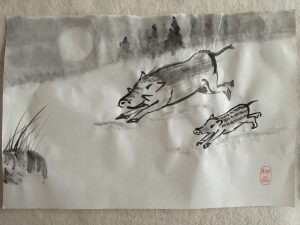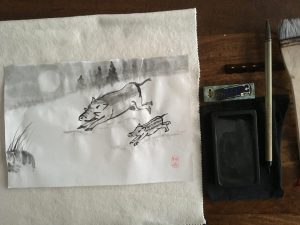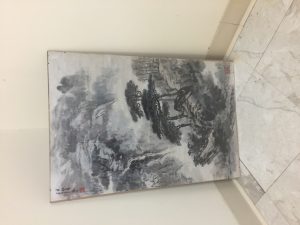The state of your brushes depends a lot on how you treat them. For example, I never let my brushes dry after only rinsing them with tap water. When they are cleaned, I rinse them quickly with demineralized water to prevent the limestone from hardening them by drying. How to smooth the hair before drying is also essential. And, of course, they have to dry the tip down.
When I started teaching, I noticed that some of my students’ brushes died after a few days, while some of my students were over 30 years old and looked almost new. Since then, I try to teach them how to correctly treat their material …
But especially, the brush ages badly if the ink is bad, the ink stone too rough and especially if the movements of the brush lack of fluidity and constantly grip the paper. When one has to “slightly” torture the brush to obtain certain effects (rocks, tree bark, etc.), it is better to use old brushes (either “bad brushes” or, preferably, good brushes that are degraded over time).
All this reminds me of Prince Wen’s cook, of whom Zhuangzi speaks.
庖為文惠君解牛,手之所觸,肩之所倚,足之所履,膝之所踦,砉然嚮然,奏刀騞然,莫不中音。合於桑林之舞,乃中經首之會。
文惠君曰:「嘻,善哉!技蓋至此乎?」
庖丁釋刀,對曰:「臣之所好者道也,進乎技矣。始臣之解牛之時,所見無非全牛者。三年之后,未嘗見全牛也,方今之時,臣以神遇而不以目視,官知止而神欲行。依乎天理,批大郤,導大窾,因其固然。技經肯綮之未嘗,而況大軱乎!
良庖歲更刀,割也;族庖月更刀,折也。今臣之刀十九年矣,所解數千牛矣,而刀刃若新發於硎。彼節者有閒,而刀刃者無厚,以無厚入有閒,恢恢乎其於游刃必有餘地矣,是以十九年而刀刃若新發於硎。雖然,每至於族,吾見其難為,怵然為戒,視為止,行為遲。動刀甚微,謋然已解,如土委地。提刀而立,為之四顧,為之躊躇滿志,善刀而藏之。」
文惠君曰:「善哉!吾聞庖丁之言,得養生焉。」
You can read a translation here:
http://www.bopsecrets.org/gateway/passages/chuang-tzu.htm
L’état de vos pinceaux dépend énormément de la façon dont vous les traitez. Par exemple, je ne laisse jamais sècher mes pinceaux après les avoir seulement rincés à l’eau du robinet. Lorsqu’ils sont nettoyés, je les rince rapidement à l’eau déminéralisée pour éviter que le calcaire ne les durcisse en sèchant. La façon de lisser les poils avant de les mettre à sécher est également essentielle. Et, bien sûr, il faut qu’ils sèchent la pointe en bas.
Lorsque j’ai commencé à enseigner, j’ai observé que les pinceaux de certains de mes étudiants étaient morts au bout de quelques jours, alors que certains des miens avaient plus de 30 ans et paraissaient presque neufs. Depuis, j’essaie de leur apprendre à correctement traiter leur matériel…
Mais surtout, le pinceau vieillit mal si l’encre est mauvaise, la pierre à encre trop rugueuse et surtout si les mouvements du pinceau manquent de fluidité et acrochent en permanence le papier. Lorsqu’on doit un peu “torturer” le pinceau pour obtenir certains effets (rochers, écorce d’arbre, etc), il vaut mieux utiliser de vieux pinceaux (soit de “mauvais pinceaux” soit, de préférence, de bons pinceaux qui se sont dégradés avec le temps).
Tout ceci me fait penser au cuisinier du prince Wen, dont parle Zhuangzi.
Vous pouvez en lire une traduction ici:
庖丁解牛-Le boucher de Zhuangzi
#BrushGrade #BrushQuality. #OldBrush #ReplaceBrush
Visit the forum at http://bit.ly/2WUPJaJ to join the discussion on Inkston Oriental Art Community Inkston Oriental Art Community » All Posts https://ift.tt/eA8V8J



